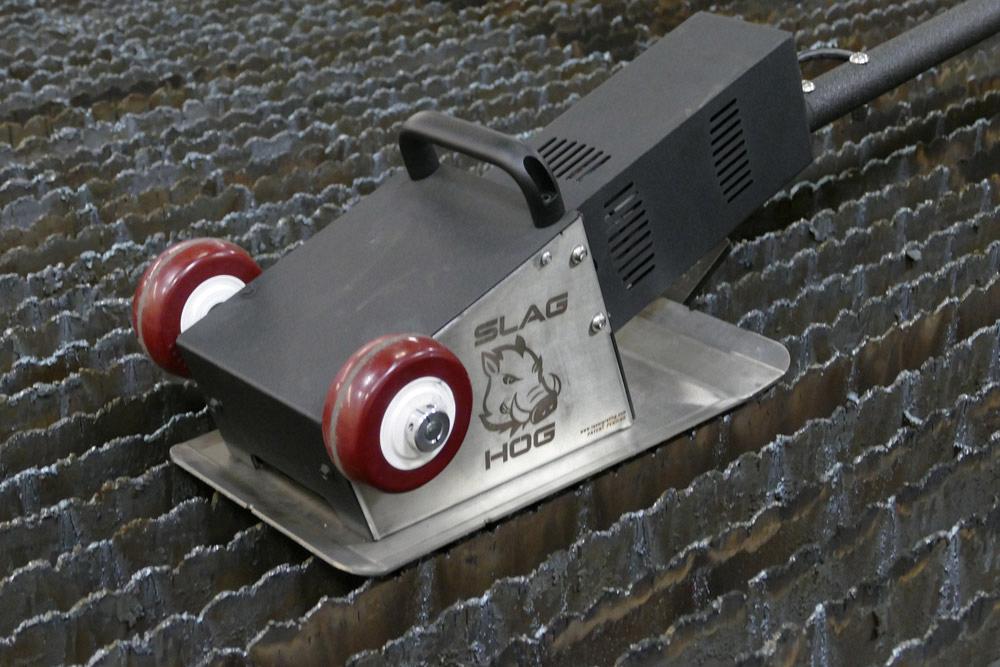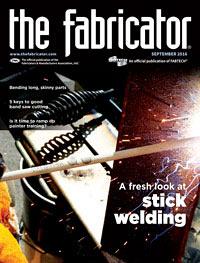Vice Pesident
- FMA
- The Fabricator
- FABTECH
- Canadian Metalworking
Categories
- Additive Manufacturing
- Aluminum Welding
- Arc Welding
- Assembly and Joining
- Automation and Robotics
- Bending and Forming
- Consumables
- Cutting and Weld Prep
- Electric Vehicles
- En Español
- Finishing
- Hydroforming
- Laser Cutting
- Laser Welding
- Machining
- Manufacturing Software
- Materials Handling
- Metals/Materials
- Oxyfuel Cutting
- Plasma Cutting
- Power Tools
- Punching and Other Holemaking
- Roll Forming
- Safety
- Sawing
- Shearing
- Shop Management
- Testing and Measuring
- Tube and Pipe Fabrication
- Tube and Pipe Production
- Waterjet Cutting
Industry Directory
Webcasts
Podcasts
FAB 40
Advertise
Subscribe
Account Login
Search
Reducing headaches associated with slag on laser grating
Proper maintenance and planning keep slats clean and improve part quality
- By Dave Fox, Eric Chalmers, and Mark Jeans
- August 2, 2016
- Article
- Laser Cutting

Figure 1
These grates used to have peaks and valleys at the top so that they could solidly support the sheet metal being laser-cut while at the same time provide room for the molten metal to drop away from the sheet and adhere to the slat. Without regular slat cleaning, however, the molten metal has nowhere to fall, possibly causing a part to be welded to the grating or simply causing the molten metal to splash back onto the underside of the laser-cut part.
Any metal fabricator that has been laser cutting for several years learns a few hard lessons along the way. One of the most painful is the need to stay on top of slat cleaning and replacement.
Does this scenario sound familiar? A 4-kW laser cutting machine with automated material load/unload functionality is set up to cut a stack of parts out of 1⁄8-inch-thick sheet metal unattended over the weekend. The mild steel slats haven’t been cleaned in several weeks, but that doesn’t mean much to the laser operator setting up the weekend job because the machine was working just fine through the last shift on Friday. The operator doesn’t realize that because the slag has built up so much on the slats that the molten metal that drips down as a result of the laser cut has nowhere to go (see Figure 1). The molten metal is going to harden, adhere to the top of the grating, and weld that sheet metal part and sheet to the slats. When the forks come to lift up the sheet with the laser-cut parts tabbed into it, the control system is going to sense the resistance and shut down as a result. (Another problem that occurs is slag buildup, which also decreases the width between the slats and can interfere with the laser machine forks that pick up the finished sheet metal after cutting.) Unless the fabricating operation has someone stopping in over the weekend or the machine is able to send a digital message to an operator, that shop is going to have an unpleasant production surprise on its hands on Monday morning.
A lack of slat maintenance also can cause minor headaches. Slag buildup can cause the molten material to bounce back onto the bottom of the material being laser-cut. That produces a marred appearance and a need for rework, where none is typically expected. For a fabrication operation working with stainless steel for food or medical applications, this can be especially disastrous as contamination from iron oxide, the result of oxygen cutting mild steel (which also is what laser grates happen to be made of in most instances), is not tolerated.
If you aren’t involved in the day-to-day operations of a laser cutting machine, you’d be surprised at how fast slag buildup occurs on slats. A typical job shop running multiple shifts might typically replace its steel slats every month if it doesn’t practice any sort of aggressive slat cleaning. A shop with newer automation might require new steel slats every two weeks if it doesn’t have a slat maintenance program in place.
Metal fabricators don’t have to live with these headaches related to slag buildup on slats. Several tools exist outside of simple pry bars and hammers that can entice even small fabricating operations to stay on top of slat maintenance in an effort to eliminate threats to part quality and maintain production efficiency.
1. Release/Antispatter Agents
Just as antispatter compounds can be used to reduce the spatter that attaches to fixtures and workpieces during welding, similar products can do the same for laser grating. The protective compound, typically applied as a liquid spray, creates a barrier over the surface on which the spatter might adhere to when cooled. The compound reduces the adhesion of molten slag to the slat surface, and the laser operator can clean the slats more easily.
Today’s compounds are water-soluble, so there is no concern about creating a hazardous waste situation when disposing of rags or slag remnants.
The liquid-based products can be applied with a pump sprayer. The release/antispatter agent should be applied weekly, but that application schedule might need to be increased if the laser cutting machine is in operation over multiple shifts during a week.
The agent doesn’t completely eliminate the slag, but it does increase the slat life and reduce how often the slats need to be cleaned or replaced.
2. Electric Slag Remover
This is a hand-held tool that simultaneously removes slag from both sides of the slat as the operator either pushes it forward along the length of the slat or draws it back (see Figure 2). Tool steel cutters knock the slag off the slat sides and top edge.

Figure 2
An electric slag removal device enables a machine operator to clean the slats while another sheet is being cut in the laser cutting chamber. It also keeps operators from having to climb on the slats and using pry bars and hammers to remove slag from the grates.
The device is designed so that one operator can clean the slats from one side of the machine. Handle length can be tailored to cover lengths from 48 to 80 in.
Fabricators that choose to go with an electric slag removal device also should consider using it in conjunction with a release agent. It speeds the slag removal process. In fact, once an operator becomes familiar with using a slag removal tool, he should be able to clean the 60 slats on a laser cutting bed in about 10 to 20 minutes. In some instances where dual pallets are in use, the laser cutting machine operator can clean the slats with the tool as parts are being cut in the enclosed area.
3. Copper Slats
There is a reason that many laser cutting machine manufacturers supply laser slats made of copper. They are much more resistant to quick slag buildup, which means that fabricators are less likely to see sheet metal parts welded to the slats (see Figure 3).
In fact, copper slats are believed to last six to eight times longer than grating made from mild steel. If a fabricator is cutting a lot of thin sheet metal or stainless steel, the copper slats, combined with routine cleaning, have been found to last up to two years.
Slag buildup does occur on copper grating, but it is also removed much more easily than slag that builds up on mild steel slats. When a metal fabricator processes thicker material on the laser cutting machine with copper slats, it can expect to see spatter from the cutting process, but it is far less than it would be if the laser had steel slats.
Copper slats are more expensive than steel grating, but fabricators can expect to spend less time on slat maintenance because the copper slats are easier to clean. When those copper slats do meet the end of their useful lives, fabricators will have a more valuable commodity on their hands for scrap dealers than if they were scrapping steel grating.
4. Mixed-Metal Slats
For those fabricators that may be hesitant to make the investment in copper grating, a hybrid slat design is available that combines copper’s longevity with as much as a 30 percent lower price tag for many slat configurations (see Figure 4). In this type of slat design, copper tips are attached to a steel underframe.
A hybrid slat design combined with a maintenance program that entails the use of a release agent and removal of slag on a regular basis can be expected to last at least four times as long as steel slats. Typically, the mixed-metal slat design works well in gauge material up to 0.187 in. thick.
In the end, the use of a release agent, an electric slag remover, copper slats, or some combination will increase the chance of producing high-quality parts on the laser cutting machine and reduce the time needed to maintain slats and extend their useful lives. Making good parts typically means a fabricator is making money, and that is a place most shops want to be.
About the Authors
subscribe now

The Fabricator is North America's leading magazine for the metal forming and fabricating industry. The magazine delivers the news, technical articles, and case histories that enable fabricators to do their jobs more efficiently. The Fabricator has served the industry since 1970.
start your free subscription- Stay connected from anywhere

Easily access valuable industry resources now with full access to the digital edition of The Fabricator.

Easily access valuable industry resources now with full access to the digital edition of The Welder.

Easily access valuable industry resources now with full access to the digital edition of The Tube and Pipe Journal.
- Podcasting
- Podcast:
- The Fabricator Podcast
- Published:
- 04/16/2024
- Running Time:
- 63:29
In this episode of The Fabricator Podcast, Caleb Chamberlain, co-founder and CEO of OSH Cut, discusses his company’s...
- Trending Articles
Capturing, recording equipment inspection data for FMEA

Tips for creating sheet metal tubes with perforations

Are two heads better than one in fiber laser cutting?

Supporting the metal fabricating industry through FMA

Hypertherm Associates implements Rapyuta Robotics AMRs in warehouse

- Industry Events
16th Annual Safety Conference
- April 30 - May 1, 2024
- Elgin,
Pipe and Tube Conference
- May 21 - 22, 2024
- Omaha, NE
World-Class Roll Forming Workshop
- June 5 - 6, 2024
- Louisville, KY
Advanced Laser Application Workshop
- June 25 - 27, 2024
- Novi, MI



























